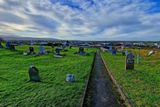Call to upgrade St John’s Famine Graveyard in Tipperary as ownership remains unclear


St John’s Famine Graveyard in Tipperary town needs urgent restoration as its footpaths are disintegrating, but there is a question mark over who owns the important local historic site.
Sinn Féin Cllr Annemarie Ryan Shiner called on the Council to assist the St John’s Famine Graveyard Committee with refurbishing the graveyard footpaths, some of which have fallen into disrepair, at the April meeting of Tipperary Cashel Cahir Municipal District.
The committee, Tipperary Town Heritage Group, and Dr Denis G Murnane, are all involved, and have been working trying to keep the cemetery in good condition. There is a Community Employment (CE) scheme to assist with maintenance, but it is unclear who owns the graveyard and who is responsible for its upkeep.
Councillor Ryan said one long footpath in particular, which runs from the hills down through the graveyard, needs work. “It could be between €20,000 and €30,000 to do a proper footpath there,” she said. “The bigger question is the ownership of it, but the footpath needs upgrading. It’s difficult for a small committee to raise that kind of money.”
Up to 1,300 adults and over 300 children are buried in mass graves there from Famine times, and there are families from Tipperary town who currently also have graves there. Burials continue to this present day.
Council is urged to assist St John's Famine Graveyard Committee in restoring the cemetery in Tipperary town where over 1,600 people are buried
Denis Holland of Tipperary County Council's Environment Section said he would meet with all stakeholders to resolve the matter.
Graveyards fall into various categories, explained Mr Holland. Back in the 1880s, when the Church of Ireland was disestablished, there was a group called the Church Temporalities Commission of Ireland set up to try and decide what would be done with all the medieval graveyards.
“They were handed over to the Board of Guardians in the Poor Law Districts,” said Mr Holland.
There are over 130 of those in Tipperary but St John’s is not one of those as it dates to about 1850. The second category of graveyards are those controlled by the Roman Catholic Church. These are generally contained with the grounds of church properties.
“It’s not belonging to the Church of Ireland because they never had any church on the site, so the only other entity it could belong to is the Workhouse,” said Mr Holland.
It was his understanding that the site had been developed as a Workhouse Burial Ground. There were nine workhouses in Tipperary and all had a burial grounds attached, some within the confines of the old workhouse buildings, but others were located some distance away from the workhouse.
St John’s Famine Graveyard either belongs to the local authority by default or it belongs to the successor of the workhouse.
“Who is the successor of the workhouse? That is a very significant legal question,” said Mr Holland. “Up to the time of the establishment of the Health Boards in 1970, the County Council had responsibility for the health services.
“So we had responsibility for what became of the workhouses. In some cases, the workhouses were changed into medical use, like Thurles and Clonmel. In other cases they were demolished like Carrick-on-Suir, and local authority houses built on them.
“In some cases, they became an educational use, like Borrisokane. So what became of the Graveyard? If I were to go and knock on the door of the HSE and say ‘you are responsible for the graveyard in St John’s’, they would probably run a mile,” said Mr Holland.
By default, it may be the local authority’s responsibility, but the land registry map will now show it as being registered in the Council’s name. This will create difficulties for any committee in applying for grant assistance.
Mr Holland said he would like to meet the committee members, and progress the issue, however the amounts available to the Environment Section for capital works in burial grounds are ‘minute’ and very restricted.



